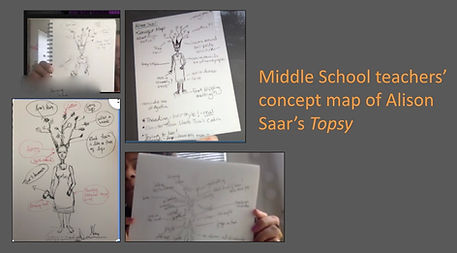top of page
-
How do we spur, encourage and support creative thinking and learning?
-
How can we engage our students in thinking deeply and broadly?
-
How do we connect art to what students are learning in school and experiencing outside of school?
DIRECTED INQUIRY TRAILS
Owl Story
Directed inquiry Trails are in-depth, teacher-directed lessons spanning one to four weeks. All lessons can be modified for any grade level or skillset.
Concepts in Portraits
Inquiry Trail Title: Concepts in Portraits
By Elizabeth Medrano, San Francisco Unified School District Art Teacher and Julia Marshall, Professor Emeritus of Art Education at San Francisco State University
Overview
In this 3-part inquiry trail, students explore portraiture as a way of conveying concepts. They will see how the juxtaposition of two art images can bring out the concepts imbedded in the works, and they will create portraits of real or imagined people that convey concepts they choose.
Timeline
5-7 sessions
Topic
Portraits
Concept/Big Idea
We can express complex concepts in portraits.
Generative Questions
How can a portrait be more than a literal depiction of a person?
How can a portrait convey an idea or concept?
Concept Web of "Topsy" by Alison Saar
Guiding Questions
What colors, shapes and images do you see in these portraits?
What gestures, stances, or postures do you see? What facial expressions?
What tells you that?
What other things like clothes and objects do you see?
What do you know about them?
Who do you think these people are?
What are their lives like?
What stories could they tell?
How are these two portraits different?
How are these two people different?
How are they alike?
How are their portraits alike?
Together, what concepts or ideas do they convey? What makes you think that?
What person or individual embodies your concept?
What gestures, facial expressions or posture express your concept?
What clothes, hairstyle, objects or background express your concept?
What does your subject do that embodies your concept?
How can you highlight/exaggerate your subject’s physical characteristics to express your concept?
What other things like symbols and artifacts from your subject’s life add to the meaning of your portrait?
Reflection Questions:
What is the concept you conveyed in your portrait?
Who is the subject of your portrait?
Why did you choose this person for your portrait?
How did you make the portrait convey your concept?
What part or trait of the portrait expresses your concept the best?
How does placing one image next to another, like when we looked at the artworks, help us to see the concepts they convey?
Inquiry Trail Title: Owl Story
By Debra Netkin, 1st-Grade Teacher in San Francisco, CA.
Click on the image to watch Debra's video.



Generative Question
What do living things need to survive?
Guiding Question
What does the Barn Owl need to survive?
Reflection Questions
What did you learn about the appearance of owls compared to the way you thought before you drew the owls?
How can you connect what owls need to survive to all living things?
How does their anatomy help them survive? How do you feel about your owls?
Overview: This is an in-depth study about one species for 1st grade. Students sketch different owls, pick one to study, then learn about what it needs to survive. It has elements of Directed and Guided Inquiry.
ApproximateTimeline
The whole unit takes about 20 hours: 2 hours per day for 4 weeks, comprised of small mini-lessons during the day, sketching time, and independent projects at activity centers.
Understanding Goals
Students/artists understand what a living thing needs to have to survive.
Cross-Curricular Connections
Science, English Language Arts
Materials
Watercolors, paint brushes, journals, oil pastels, construction paper, paper for books, and staplers.
First-grade students' art and writing displays
bottom of page



